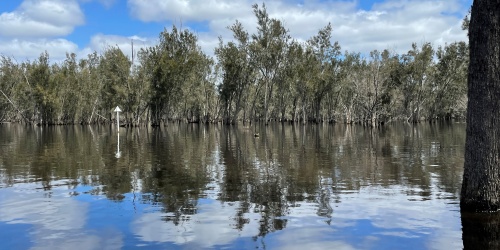Threatened ecological communities
Maintaining functioning ecosystems is often central to conserving the plants and animals within them.

What is a threatened ecological community?
An ecological community is a naturally occurring assemblage of organisms that occurs in a particular habitat. Ecological communities may comprise various life forms including plants, animals and microorganisms, andfac provide an important level of biological diversity in addition to genetics and species.
Since 1994, the department has been identifying and listing ecological communities as threatened through a non-statutory process if the community was presumed to be totally destroyed or at risk of becoming totally destroyed. Threatened ecological communities (TECs) are also provided protection under Western Australian legislation through the Environmental Protection Act 1986 and Environmental Protection (Clearing of Native Vegetation) Regulations 2004.
The Biodiversity Conservation Act 2016 (BC Act) provides for the statutory listing of TECs by the Minister under the categories critically endangered, endangered or vulnerable. The new legislation also describes statutory processes for preparing recovery plans for TECs, the registration of their critical habitat, and penalties for unauthorised modification of TECs.
The first listing of TECs under the BC Act was made on 26 May 2023. Currently, 65 ecological communities are listed as threatened under the BC Act in the following categories:
- 45 critically endangered
- 9 endangered
- 11 vulnerable
Of these, 27 are also listed under the Commonwealth's Environment Protection and Biodiversity Conservation Act 1999.
Ecological communities that were listed as ‘presumed totally destroyed’ under Western Australia’s non-statutory process will now be considered for listing as collapsed ecological communities under the BC Act.
Threatened ecological communities list
Visit the List of threatened ecological communities page to download the list.
Priority ecological communities list
As at December 2022, an additional 390 ecological communities (community types and sub-types) with insufficient information available to be considered a TEC, or which are rare but not currently threatened have been placed on the Priority list and referred to as priority ecological communities (PECs). The TECSC also provides advice on PECs.
How are these communities managed?
Because ecosystems and the links between their community members are so complex, it is important to identify, maintain and manage whole ecosystems, their processes and communities (including the many thousands of species of invertebrates, non-flowering plants like fungi and seaweeds, and micro-organisms), rather than just on a species-by-species basis.
It is also more cost effective and efficient to prevent species from becoming threatened by conserving them as part of viable, functioning communities than it is to attempt to manage individual species.
DBCA manages the parks and reserves under its care in accordance with the Conservation and Land Management Act 1984. TECs and PECs are given priority consideration when planning and carrying out activities including the management of weeds, pests, diseases, fire, hydrology and visitor access, with the aim of protecting them, restoring their values and decreasing their vulnerability to threatening processes
Threatened ecological community occurrences
TEC and PEC occurrences are entered into the threatened and priority ecological community database. For information on occurrences email communities.data@dbca.wa.gov.au.
Visit the Threatened ecological community monitoring resources page for information and resources relating to the identification, survey and monitoring of threatened ecological community occurrences, including how and when to submit a report form.
Threatened ecological community fact sheets
Learn about Western Australia’s threatened ecological communities and find information on their distribution, conservation status, threatening processes and priority recovery actions.


